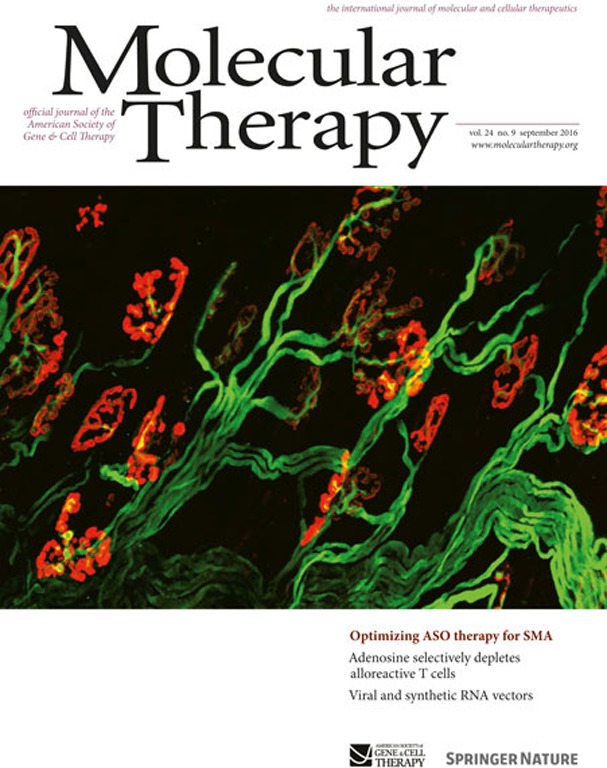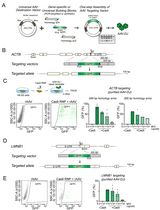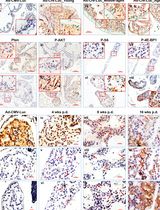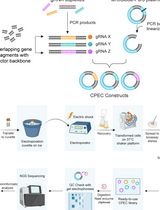- EN - English
- CN - 中文
Advanced Design of Minimalistic Dumbbell-shaped Gene Expression Vectors
极简化哑铃形基因表达载体的优化设计
发布: 2017年08月05日第7卷第15期 DOI: 10.21769/BioProtoc.2425 浏览次数: 10093
评审: Longping Victor TseKanika GeraAnonymous reviewer(s)
Abstract
Minimal DNA vectors exclusively comprising therapeutically relevant sequences hold great promise for the development of novel therapeutic regimen. Dumbbell-shaped vectors represent non-viral non-integrating DNA minimal vectors which have entered an advanced stage of clinical development (Hardee et al., 2017). Spliceable introns and DNA nuclear import signals such as SV40 enhancer sequences are molecular features that have found multiple applications in plasmid vectors to improve transgene expression. In dumbbells however, effects triggered by introns were not investigated and DNA-based nuclear import sequences have not found applications yet, presumably because dumbbell vectors have continuously been minimized with regard to size. We investigated the effects of an intron and/or SV40 enhancer derived sequences on dumbbell vector driven reporter gene expression. The implementation of a spliceable intron was found to enhance gene expression unconditionally in all investigated cell lines. Conversely, the use of the SV40 enhancer improved gene expression in a cell type-dependent manner. Though both features significantly enlarge dumbbell vector size, neither the intron nor the enhancer or a combination of both revealed a negative effect on gene expression. On the contrary, both features together improved dumbbell-driven gene expression up to 160- or 56-fold compared with plasmids or control dumbbells. Thus, it is highly recommended to consider an intron and the SV40 enhancer for dumbbell vector design. Such an advanced design can facilitate pre-clinical and clinical applications of dumbbell-shaped DNA vectors.
Keywords: Dumbbell vector (哑铃形载体)Background
Although many genes have been expressed using dumbbell-shaped DNA vectors, most of these applications used the basic design comprising a promoter, the coding sequence (CDS), and a transcriptional terminator. Some vectors included a chimeric intron, however, it was not reported whether transgene expression was enhanced by this design (Schirmbeck et al., 2001). Here we studied the effects triggered by molecular features that frequently find applications in plasmid design on dumbbell-driven gene expression: 1. A chimeric intron derived from the human β-globin gene–splicing is known to facilitate RNA processing, nuclear export, and subsequently gene expression (Luo and Reed, 1999); and 2. The Simian virus 40 (SV40) enhancer which can enhance the activity of the homologous SV40 promoter and which in addition was reported to function as an active DNA nuclear import sequence (Dean, 1997; Dean et al., 1999). The proposed mechanism behind this phenomenon is that the SV40 enhancer recruits transcription factors harboring protein nuclear import signals in the cytoplasm and that the vector DNA is piggyback translocated into the nucleus with support of the protein nuclear import machinery. We generated luciferase-expressing dumbbell vectors harboring either both, only one or none of these molecular features and monitored transgene expression in HEK293T and HepG2 cells. Our data demonstrate that introns and the SV40 enhancer can substantially improve dumbbell vector design (Jiang et al., 2016).
Materials and Reagents
- Pipette tips (Corning® Isotip® filtered 0.2-10 μl) (Corning, catalog number: 4807 )
- Pipette tips (Axygen® TF200RS 1-200 μl) (Corning, Axygen®, catalog number: TF-200-R-S )
- Pipette tips (Axygen® TF1000RS 100-1,000 μl) (Corning, Axygen®, catalog number: TF-1000-R-S )
- 1.5 ml microcentrifuge tubes (RNase, DNase and Pyrogen-Free) (Corning, Axygen®, catalog number: MCT-150-C )
- 0.2 ml thin-walled PCR tubes (Thermo Fisher Scientific, Thermo ScientificTM, catalog number: 3412 )
- FalconTM 50 ml conical centrifuge tubes (Corning, Falcon®, catalog number: 352070 )
- T-75 flask (Corning, catalog number: 3290 )
- 24-well cell culture plate (Corning, catalog number: 3527 )
- 96-well plate (Thermo Fisher Scientific, Thermo ScientificTM, catalog number: 442404 )
- HEK293T cells (ATCC, catalog number: CRL-3216 )
- HepG2 cells (ATCC, catalog number: HB-8065 )
- pGL3-control vector (Promega, catalog number: E1741 )
- One Shot® TOP10 Chemically Competent E. coli (Thermo Fisher Scientific, InvitrogenTM, catalog number: C404010 )
- Chimeric human β-globin intron sequence (Gene synthesis, GeneArt, Applied Biosystems): 5’-CAGGTAAGTATCAAGGTTACAAGACAGGTTTAAGGAGACCAATAGAAACTGGGCTTGTCGAGACAGAGACGACTCTTGCGTTTCTGATAGGCACCTATTGGTCTTACTGACATCCACTTTGCCTTTCTCTCCACAGG-3’
- SV40 enhancer sequence: 5’-CGATGGAGCGGAGAATGGGCGGAACTGGGCGGAGTTAGGGGCGGGATGGGCGGAGTTAGGGGCGGGACTATGGTTGCTGACTAATTGAGATGCATGCTTTGCATACTTCTGCCTGCTGGGGAGCCTGGGGACTTTCCACACCTGGTTGCTGACTAATTGAGATGCATGCTTTGCATACTTCTGCCTGCTGGGGAGCCTGGGGACTTTCCACACCCTAACTGACACACATTCCACAGC-3’
- Oligonucleotide primers for chimeric intron amplification (Synthesized by Integrated DNA Technologies, 25 nmol scale, deprotected desalted):
intron-Fw: 5’-ATCTATCGGGATCCAAGCTTCAGGTAAGTATCAAGGTTACAAGACAGG-3’
intron-Rv: 5’-CATTATCTGGATCCCCATGGACCCTGTGGAGAGAAAGGCAA-3’ - Loop sequences (Synthesized by Integrated DNA Technologies, 25 nmol scale, deprotected desalted):
Loop-1: 5’-pGATCTGACCAGTTTTCTGGTCA-3’
Loop-2: 5’-pTCGACAGGCTCTTTTGAGCCTG-3’ - Oligonucleotide primers for poly(A) signal (Synthesized by Integrated DNA Technologies, 25 nmol scale, deprotected desalted):
polyA-Fw: 5’-TGTAATTCTAGAGTCGGGGCG-3’
polyA-Rv: 5’-ATCTATCGGGATCCTTACCACATTTGTAGAGGTT-3’ - FastDigest HindIII (Thermo Fisher Scientific, Thermo ScientificTM, catalog number: FD0504 )
- FastDigest NcoI (Thermo Fisher Scientific, Thermo ScientificTM, catalog number: FD0573 )
- FastDigest BamHI (Thermo Fisher Scientific, Thermo ScientificTM, catalog number: FD0054 )
- FastDigest BglII (Thermo Fisher Scientific, Thermo ScientificTM, catalog number: FD0083 )
- FastDigest XhoI (Thermo Fisher Scientific, Thermo ScientificTM, catalog number: FD0694 )
- FastDigest SalI (Thermo Fisher Scientific, Thermo ScientificTM, catalog number: FD0644 )
- FastDigest AseI (Thermo Fisher Scientific, Thermo ScientificTM, catalog number: FD0914 )
- UltraPureTM DNase/RNase-free distilled water (Thermo Fisher Scientific, InvitrogenTM, catalog number: 10977015 )
- T7 DNA polymerase (10 U/µl) (Thermo Fisher Scientific, Thermo ScientificTM, catalog number: EP0081 )
- Taq DNA polymerase, recombinant (5 U/µl) (Thermo Fisher Scientific, Thermo ScientificTM, catalog number: EP0402 )
- 10x FD buffer (Thermo Fisher Scientific, Thermo ScientificTM, catalog number: B64 )
- T4 DNA ligase (5 U/µl) (Thermo Fisher Scientific, Thermo ScientificTM, catalog number: EL0014 )
- dNTP set 100 mM solutions (Thermo Fisher Scientific, Thermo ScientificTM, catalog number: R0181 )
- QIAquick PCR purification kit (QIAGEN, catalog number: 28106 )
- Potassium acetate (Sigma-Aldrich, catalog number: P1190-100G )
- Agarose, LE, analytical grade (Promega, catalog number: V3125 )
- Ethanol, absolute (Fisher Scientific, catalog number: BP28184 )
- Sodium chloride (NaCl) (Sigma-Aldrich, catalog number: S9888-500G )
- Magnesium chloride hexachloride (MgCl2·6H2O) (Sigma-Aldrich, catalog number: M2670-100G )
- Tris-HCl (Roche Diagnostics, catalog number: 10812846001 )
- Ethylenediaminetetraacetic acid (EDTA) (Sigma-Aldrich, catalog number: EDS-100G )
- Adenosine 5’-triphosphate disodium salt hydrate (Sigma-Aldrich, catalog number: A2383-1G )
- Ethidium bromide solution (Bio-Rad Laboratories, catalog number: 1610433 )
- Phenol solution (Sigma-Aldrich, catalog number: P4557-100ML )
- Chloroform (Sigma-Aldrich, catalog number: 288306-1L )
- 3-Methyl-1-butanol (Sigma-Aldrich, catalog number: 309435-100ML )
- GeneRuler DNA Ladder Mix (Thermo Fisher Scientific, Thermo ScientificTM, catalog number: SM0331 )
- HyClone Dulbecco’s modified Eagles medium/high glucose with L-glutamine, sodium pyruvate (GE Healthcare, HyCloneTM, catalog number: SH30243.01 )
- HyClone Standard Fetal Bovine Serum (GE Healthcare, HyCloneTM, catalog number: SH30088.03 )
- Penicillin-streptomycin (10,000 U/ml) (Thermo Fisher Scientific, GibcoTM, catalog number: 15140122 )
- Lipofectamine® 2000 Transfection Reagent (Thermo Fisher Scientific, InvitrogenTM, catalog number: 11668019 )
- Opti-MEM® I Reduced Serum Medium (Thermo Fisher Scientific, GibcoTM, catalog number: 31985070 )
- Luciferase Assay System (Promega, catalog number: E1501 )
- Liquid nitrogen
- TE buffer (see Recipes)
Equipment
- Pipettes (Gilson, PIPETMAN Classic®, P2 , P20N , P200N , and P1000N )
- CO2 incubator (Thermo Electron)
- Shaker (Heidolph Instruments, model: Unimax 2010 )
- Glass beaker (Schott, Duran)
- Standard thermal cycler (Thermo Fisher Scientific, Applied BiosystemsTM, model: GeneAmp PCR System 9700 )
Note: This product has been discontinued. - Gel doc (Bio-Rad Laboratories, Gel Doc Imager)
- Gel running apparatus (Amersham Biosciences)
- Gel staining tray (GE Healthcare)
- Benchtop centrifuge (Eppendorf, model: 5430 R )
- Heat block (Thermomixer comfort) (Eppendorf)
- Spectrophotometer (Thermo Fisher Scientific, Thermo ScientificTM, model: NanoDropTM 2000 )
- Microwave (Panasonic)
- Class II Biological Safety Cabinet (Gelman)
- Synergy H1 Multi-Mode Reader (BioTek Instruments, model: Synergy H1 )
Software
- GraphPad Prism software 5.0
Procedure
文章信息
版权信息
© 2017 The Authors; exclusive licensee Bio-protocol LLC.
如何引用
Jiang, X. and Patzel, V. (2017). Advanced Design of Minimalistic Dumbbell-shaped Gene Expression Vectors. Bio-protocol 7(15): e2425. DOI: 10.21769/BioProtoc.2425.
分类
微生物学 > 微生物生物化学 > DNA
分子生物学 > DNA > 基因表达
分子生物学 > DNA > DNA 克隆
您对这篇实验方法有问题吗?
在此处发布您的问题,我们将邀请本文作者来回答。同时,我们会将您的问题发布到Bio-protocol Exchange,以便寻求社区成员的帮助。
提问指南
+ 问题描述
写下详细的问题描述,包括所有有助于他人回答您问题的信息(例如实验过程、条件和相关图像等)。
Share
Bluesky
X
Copy link














